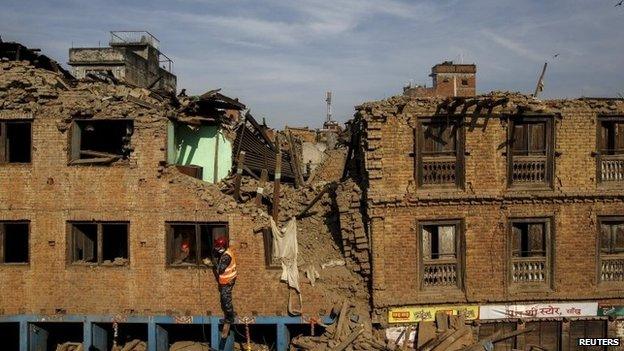Why the earthquake danger is not over for Nepal
- Published

The 7.8-magnitude earthquake is now known to have killed more than 7,000 people
The tent cities that used to be in every park and open space in Kathmandu are gradually vanishing as people return to their homes.
It shows that, at last, Nepal is returning to a semblance of normality, but it also represents a legacy of terrible danger.
The wrecked houses are the most obvious evidence of the terrible destruction the earthquake wreaked here in Nepal, but the damage to property is far more extensive.
Despite what you see in the news, much of Nepal appears untouched by the earthquake.
But look closer and there are signs that all is not well.
Driving through Kathmandu you notice that, like drunks, many buildings list very slightly to one side. Other have slumped against their neighbours.
Some structures stand erect, but with ugly cracks. The damage to other buildings is invisible.
Yet it is impossible not to sympathise with people who want to go back to their homes. The makeshift camps in which many Nepalese people have been living are dirty, unhygienic places.
It is estimated that nearly 150,000 people were living in tents and under tarpaulins in Tundikhel Park in the centre of Kathmandu last week.
By this weekend there were fewer than 10,000.
"I'm still scared, and our house still has cracks all over it," Tara Magar told the New York Times , externala couple of days ago, "but we don't want to stay here any longer."
She said she was going home because she just couldn't stand the smell of the park toilets any more.
Fair enough. I know how quickly you can shrug off the risk from earthquakes.
We turned up at our hotel in Kathmandu in the middle of Sunday night, the day after the earthquake struck.
I'd had my own earthquake experience that day. We were filming when the biggest of the aftershocks struck. At 6.9 magnitude it was a major earthquake in its own right.
As the receptionist processed our papers I glanced around the lobby.
I didn't spot the cracks at first, but as soon as I'd seen one I realised the whole place was traced with a spider web of little fissures and fault-lines.
That night I slept at the BBC office in Kathmandu, a building I knew had been checked for earthquake safety.
But by the following night I was exhausted and collapsed gratefully into my hotel bed.
(The hotel assures me, by the way, that it has subsequently got the all-clear from a structural engineer.)
I've met Nepalese people who have lost everything: family, friends, homes and possessions.
The BBC's Justin Rowlatt: "There is virtually nothing left of Langtang"
These people are unquestionably the priority for aid and assistance.
But the wider structural damage the earthquake and its aftershocks caused cannot be ignored.
As I have written many Nepalese people believe they were lucky, the earthquake could have done much more damage.
But the earthquake danger is not over for Nepal.
The first results from the EU's Sentinel 1 satellite show that last Saturday's earthquake in Nepal did not rupture the surface, reports the excellent Kate Ravillious.
That suggests, say seismologists, that significant strain may still be stored on that segment of the fault: another large earthquake could hit in the coming decades.
Billions will need to be spent to ensure that the damage done by this earthquake doesn't end up massively magnifying the effects of the next one.